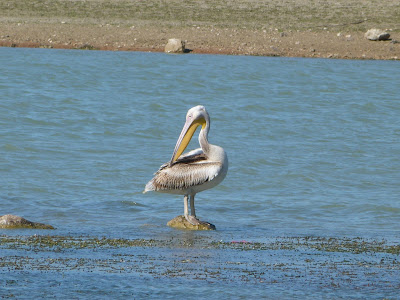Stanwell Moor
By far the coldest day yet, this winter, with a very light wind and a heavy frost that lingered all morning. We set five nets, three in the reed-bed and another two across the track from the stream. There didn't seem to be much about and catching progressed slowly. In just over three hours we captured 10 new and 6 retrapped birds.
We caught four Chiffchaffs, all with fat scores of zero, a Cetti's Warbler along with a few Wrens and Long-tailed Tits, and three Robins which were all local re-traps.
Total: 10 (6)
Wren - 2 (1)
Dunnock - 0 (1)
Robin - 0 (3)
Cetti's Warbler - 1
Chiffchaff - 4
Long-tailed Tit - 3 (1)
Staines Moor
This is a wintering site for Water Pipit, a species that visits the UK in relatively low numbers each winter. The annual number ringed in this country is usually low, 10 in 2015, 12 in 2014, 1 in 2013, 9 in 2012. One of these was a bird ringed in our adjacent site, Stanwell Moor, in November 2012 with another in November 2010. We managed to get permission to target Water Pipits over on Staines Moor and thought that a colour ringing project would be worthwhile, if catching was possible. This is a very open site with a lot of dog walkers, often with dogs running off the lead.
Today, at midday, we arranged to meet the Countryside and Commons officer responsible for the area for an initial try at capturing Water Pipits. We put up two, two panel 12m nets alongside the river, tried audio-lures (appropriate licence endorsements held) and waited. There were a few birds around, although more Wagtails than Pipits and we had no captures for quite a while. The first bird was flushed into the net by a birder walking by the river's edge.
As the temperature began to drop we also caught a second bird. Both were fitted with metal rings - and the order for colour rings will be put in very shortly as this first try leaves us hopeful that a reasonable proportion of birds present may be captured. This is being done to aid monitoring the birds using the Moor without the need for recapture, and hopefully will give an indication of whether they winter at the site for the whole winter period, how faithful they are to the site each year, longevity and hopefully with luck (if they are reported, from other locations, during the summer months) where they breed.
Total: 2
Water Pipit - 2
By far the coldest day yet, this winter, with a very light wind and a heavy frost that lingered all morning. We set five nets, three in the reed-bed and another two across the track from the stream. There didn't seem to be much about and catching progressed slowly. In just over three hours we captured 10 new and 6 retrapped birds.
We caught four Chiffchaffs, all with fat scores of zero, a Cetti's Warbler along with a few Wrens and Long-tailed Tits, and three Robins which were all local re-traps.
Chiffchaff
Robin, age 3
Cetti's Warbler, age 3
Wren - 2 (1)
Dunnock - 0 (1)
Robin - 0 (3)
Cetti's Warbler - 1
Chiffchaff - 4
Long-tailed Tit - 3 (1)
Staines Moor
This is a wintering site for Water Pipit, a species that visits the UK in relatively low numbers each winter. The annual number ringed in this country is usually low, 10 in 2015, 12 in 2014, 1 in 2013, 9 in 2012. One of these was a bird ringed in our adjacent site, Stanwell Moor, in November 2012 with another in November 2010. We managed to get permission to target Water Pipits over on Staines Moor and thought that a colour ringing project would be worthwhile, if catching was possible. This is a very open site with a lot of dog walkers, often with dogs running off the lead.
Today, at midday, we arranged to meet the Countryside and Commons officer responsible for the area for an initial try at capturing Water Pipits. We put up two, two panel 12m nets alongside the river, tried audio-lures (appropriate licence endorsements held) and waited. There were a few birds around, although more Wagtails than Pipits and we had no captures for quite a while. The first bird was flushed into the net by a birder walking by the river's edge.
Water Pipit, 2513265, age 3
Water Pipit 2513266, age 3
Total: 2
Water Pipit - 2
























































